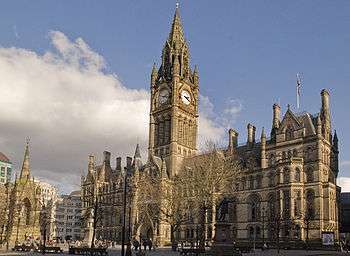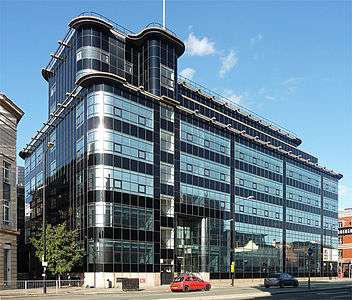Manchester Cenotaph
| The Cenotaph | |
|---|---|
| United Kingdom | |
|
Relocated Cenotaph in 2014 | |
|
For the British Empire (later Commonwealth) dead of both World Wars, and the British military in later wars | |
| Unveiled | 12 July 1924 |
| Location |
53°28′39″N 2°14′38″W / 53.4776°N 2.2438°WCoordinates: 53°28′39″N 2°14′38″W / 53.4776°N 2.2438°W St Peter's Square, Manchester, United Kingdom |
| Designed by | Edwin Lutyens |
The Manchester Cenotaph in St Peter's Square, Manchester, England, was designed by Sir Edwin Lutyens. Built in Portland stone, it was erected in 1924 as a memorial to those who lost their lives in the First World War. It is a Grade II* listed building.
History
Proposals for a war memorial to commemorate Manchester's fallen soldiers began soon after the end of the First World War in 1918 and the Manchester War Memorial Committee was established to undertake the necessary planning. The cenotaph's foundation stone was laid in November 1923.[1]
The memorial was unveiled on 12 July 1924[2] by Lord Derby and Mrs Bingle who had lost three sons in the war. The memorial was unveiled in front of a large crowd and guard of honour from the Manchester Regiment and ex-servicemen. The service was led by the Dean of Manchester, Rev J. G. McCormick and the Baptist minister Rev E. J. Roberts. Mrs Bingle represented "the mothers and wives of Manchester who had made sacrifices greater than life itself". She wore the eight medals won by her three dead sons, Sergeant Ernest Bingle aged 34 and Gunner Charles Bingle aged 27 of the Royal Garrison Artillery and Corporal Nelson Bingle aged 21 of the Royal Engineers. Lord Derby remarked that the memorial was not only a tribute to the dead but a warning as to the cost of war.[3]
In 1949 the dates for World War II were added and the surrounding area was made into a garden of remembrance.[2] The cenotaph was designated a Grade II* listed building on 3 September 1974.[4]
In March 2011 Manchester City Council began a consultation on moving the cenotaph to an alternative site in St Peter's Square to allow for the expansion of the Metrolink.[5] The plans had a mixed reception as some objections were made by the public but there was support from veterans, church and heritage groups. The relocation was approved in 2012, and in January 2014 the cenotaph was dismantled and put in storage before it was cleaned and restored.[6]
Design

The cenotaph was designed by Sir Edwin Lutyens.[4] It is similar to the one he designed for Whitehall; "a pylon in diminishing stages with a figure of the Unknown Soldier draped in a greatcoat on top".[7] The north-east side of the memorial bears the inscription in capital letters: To the honoured memory of those who gave their lives for their country. On the south west side the inscription, again in capitals, is: O Lord God of our fathers keep forever in the imagination of the thoughts of the heart of thy people.
The 42-feet high cenotaph is made of 160 tons of Portland stone.[1] The three-stage rectangular cenotaph sits on a low plinth; the top-most stage has a wreath containing the city's coat of arms on each side, a sword pendant on the front, and a recumbent casualty on a catafalque. Two obelisks are situated to the rear at either side of a stone sarcophagus.[2][4][8]
Location
The monument was located in St Peter's Square in front of Manchester Central Library, in a memorial garden designed by L. C. Howitt on the site of St Peter's Church. The church was built there in 1789–94 by James Wyatt and was demolished in 1907. A Portland stone cross by Temple Moore commemorated the old church.[9] The site was a compromise choice, after proposals for locating it in Albert Square and Piccadilly Gardens were rejected.
In 2014 the cenotaph was reconstructed in a new memorial garden aligned with the southern entrance to the town hall.[6] The garden opened to the public in September 2014, but the cenotaph was damaged in the first week when skateboarders began using the area as a skatepark.[10] Repair work costing £4,000 started shortly afterwards, and extra security measures (including 24-hour CCTV coverage) were put in place.[11]
See also
| Wikimedia Commons has media related to Manchester Cenotaph. |
- Northampton War Memorial, another Lutyens memorial with flanking obelisks (flanking a Stone of Remembrance rather than a cenotaph)
- Grade II* listed buildings in Greater Manchester
- Grade II* listed war memorials in England
References
Bibliography
- Hartwell, Clare (2002). Manchester. Pevsner Architectural Guides. London: Penguin. ISBN 978-0-14-071131-8.
- Hartwell, Clare; Hyde, Matthew; Pevsner, Nikolaus (2004). Lancashire: Manchester and the South-East. The Buildings of England. New Haven;London: Yale University Press. ISBN 0-300-10583-5.
- Wyke, Terry; Cocks, Harry (2004). Public Sculpture of Greater Manchester. Liverpool: Liverpool University Press. ISBN 9780853235675.
Citations
- 1 2 "Manchester Cenotaph". Western Daily Press. 8 November 1923. p. 6. – via British Newspaper Archive (subscription required)
- 1 2 3 "Manchester Cenotaph". War Memorials Register. Imperial War Museums. Retrieved 2016-11-18.
- ↑ "Manchester Memorial Bereaved mother assists in unveilling ceremony". Yorkshire Post and Leeds Intelligencer. 14 July 1924. p. 5. – via British Newspaper Archive (subscription required)
- 1 2 3 Historic England. "Manchester War Memorial (1270697)". National Heritage List for England. Retrieved 23 October 2016.
- ↑ "Manchester's cenotaph 'could be moved'". BBC News. 8 March 2011.
- 1 2 "Workmen start on cenotaph relocation". Manchester Evening News. 25 January 2014. Retrieved 2014-10-20.
- ↑ Hartwell (2002) p. 202.
- ↑ Wyke, pp. 130–132
- ↑ Hartwell (2004) p. 332.
- ↑ "Fury as bizarre graffiti daubed on bench at newly restored cenotaph". Manchester Evening News. 30 September 2014. Retrieved 2014-10-13.
- ↑ "Manchester's cenotaph to be monitored by 24-hour CCTV after £4,000 damage". Manchester Evening News. 6 October 2014. Retrieved 2014-10-20.





